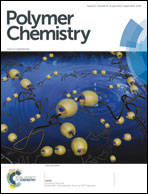Facile one-spot synthesis of highly branched polycaprolactone†
Abstract
Reported is the first solvent-free (bulk) synthesis of degradable/bioresorbable, highly branched polymers via tin octanoate Sn(Oct2) catalysed controlled ring opening co-polymerisation (ROP) of mono and di-functional lactone monomers that proceed to near quantitative conversion. The successful isolation of solvent soluble, highly branched structures was shown to be dependent on both the concentration of the di-functional monomer and the overall reaction time. Comparison with analogous systems utilising controlled radical polymerisation (CRP) to form the highly/hyper branched polymers suggested significant experimental differences between the two chain growth methods. The maximum proportion of di-functional monomer without gelation ensuing was found to be 0.6 equivalents w.r.t. mono-functional monomer (c.f. 1 with CRP) and the onset of significant levels of branching occurred at approximately 90% conversion (c.f. ∼70% with CRP). These differences and significant disparity in reaction times were attributed to (a) the coordination and insertion (C + I) propagation mechanism adopted by the Sn catalyst and (b) the presence of additional trans-esterification reactions at high conversion. Evidence is presented to support the conclusion that there are two mechanisms contributing to the overall branching process in the ROP system at high conversion. First, the C + I mechanism promotes growth of linear polymer until approximately 90% conversion, after which both the C + I and trans-esterification processes contribute to the interchain branching process. The branched nature of the molecular structures was supported by confirmation plots generated from static light scattering. This data demonstrated that the polymers synthesised exhibit varying degrees of branching, consistent with the di-functional monomer (4,4′-bioxepanyl-7,7′-dione – BOD) concentration in the feed. The degree of branching was calculated using 3 different methods and the results were shown to be independent of method. Finally, DSC analysis of the polymers demonstrated correlation between the degree of branching achieved and the observed Tm for the material where increased branching leads to a drop in the recorded Tm.


 Please wait while we load your content...
Please wait while we load your content...